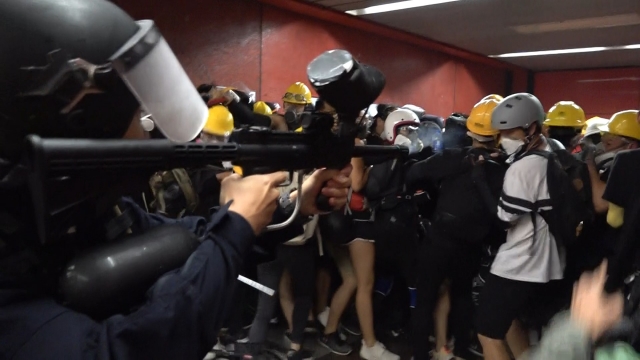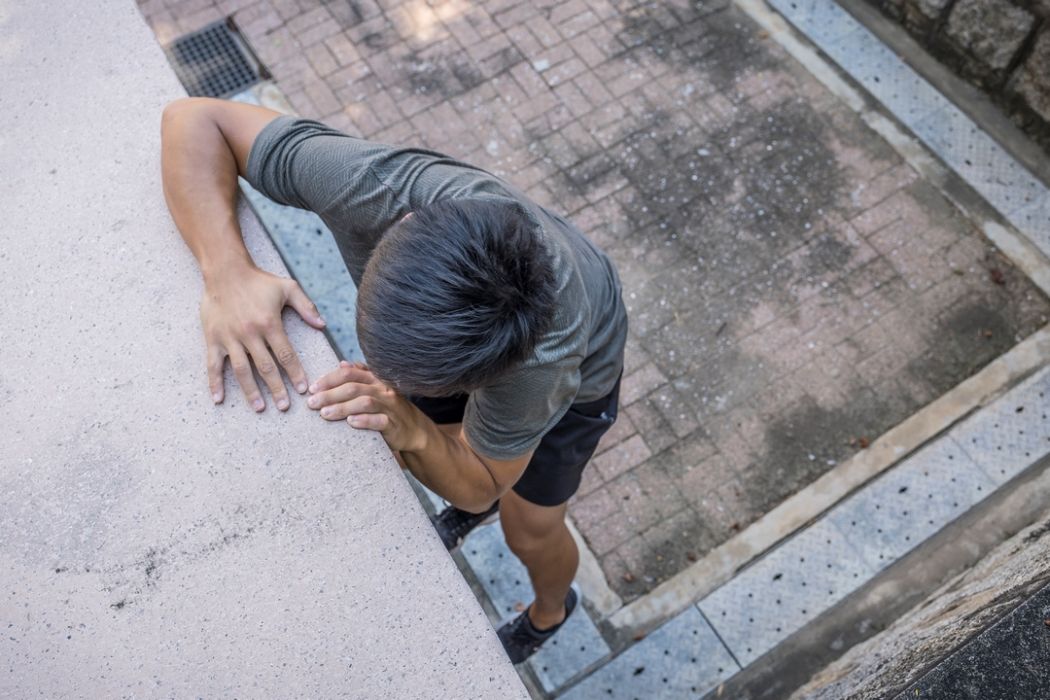Two sinewy figures whizz across a metre-high railing, contorting their bodies as they glide over with slick ease. It is a move they both told HKFP civilians can use to safely flee some of Hong Kong’s chaotic protester-police clashes.
Gon Lo and Baoson Cheng are part of a community of free runners passing on their parkour tricks to members of the public in light of what they described as increasingly volatile situations arising from the city’s nearly 17 consecutive weeks of unrest.

What began as a series of protests against a now-soon-to-be-withdrawn extradition bill has morphed into sometimes violent displays of dissent against Beijing’s encroachment, alleged police misconduct, and other community grievances. Scores of people have been injured in ugly clashes with officers firing over 2,000 rounds of tear gas and protesters hurling flaming projectiles.
According to Now TV, 13 of the city’s 18 districts have been affected by tear gas including residential parts of Sham Shui Po and rural Yuen Long, with civilians finding themselves caught in the middle.
Cheng, 24, said the hairiest situations arose when police baton-charged protesters or fired tear gas in densely populated areas, which risked a stampede as crowds scatter.
In a dramatic Apple Daily video on August 11, fleeing demonstrators clustered at the top of stationary escalators at Tai Koo MTR station as an officer fired pepper balls at them at close range. As the group broke free, some tumbled down the jagged steps with riot police in hot pursuit.

Along Harcourt Road—a frequent flashpoint owing to its proximity to the Legislative Council Complex—protesters have often been seen awkwardly clambering over dividers or finding shallow dips to use as steps during frantic police dispersal operations.
‘Obstacles are an opportunity’
Lo, 27, said that such incidents could have been avoided had those involved known how to scale the obstacles, such as sliding down the side of escalators or keeping a low centre of gravity when jumping barriers to soften the impact of landing.
“When the protests happened, I saw a lot of people would get hurt,” he said. “Some people—they don’t know how to get out. But in parkour, obstacles are an opportunity.”
“I thought I should share some of my techniques or skills, or what I know from parkour, to help Hong Kong people escape dangerous situations.”

The day before an estimated one million people took to the streets to protest against the extradition bill on June 9, Lo posted his first parkour tutorial to Facebook on ways to jump over metal barriers: sit-turn, butterfly, safety vault—each move cooly executed with subtitles to instruct viewers on how to place their bodies.
“I thought people could learn a lot of useful things from me, so I filmed some videos for them to practice and apply when they need to use it, to protect themselves and even their friends,” he said.
The full-time parkour instructor and performer has been applying these techniques to his triweekly classes.

Hong Kong has no shortage of hurdles for students to practice on. The urban jungle is littered with concrete blocks and railings designed to direct the flow of people. But for free runners, the barriers provide a unique chance to bend these rules.
“A lot of people think an obstacle is an obstacle, but we will play with it,” Cheng said. “It’s changed the way that I look at the world.”
Moments before while exhibiting his moves he had scaled a wall almost double his height, planting his toes firmly on its surface and latching onto the top before hoisting himself up.

It was a move that is harder than it looked but one that Cheng insisted came with daily practice: “If you’re only training for one event then you’re only training for a short period of time,” he said. “You can’t use the technique efficiently so you can easily get injured or get stuck or hurt yourself.”
“It should be a daily habit, not only for parkour but also [to improve] your fitness,” Lo added. “I would feel unsafe if I wasn’t fit.”
Publicly available
In recent weeks, videos have emerged of students practising jumping over MTR turnstiles—a tactic which enables them to make a quick escape and avoid paying using their travel cards, widely believed to be used to track their movements. Meanwhile, in a clip shared on social media, a free runner was also filmed doing an impressive flip across an MTR barrier.
But the pair rejected the notion that they were helping those at unauthorised mass gatherings evade police capture.

“We are not quite focused on the protests but what we practice can be applied to those kinds of situations. It not only affects protesters but also bystanders,” Lo said.
He pointed out that all of the video materials are publicly available online and free to view.
“If you want to learn, you can learn for yourself,” Cheng said. “Even the police can learn from our videos!”
Hong Kong Free Press relies on direct reader support. Help safeguard independent journalism and press freedom as we invest more in freelancers, overtime, safety gear & insurance during this summer’s protests. 10 ways to support us.

